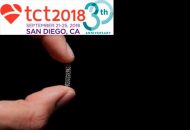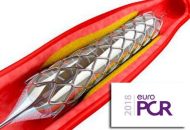Despite our high hopes for new-generation drug-eluting stents (DES), patients with diabetes still have a different prognosis, both clinical and angiographic, compared with non-diabetic patients. Authors sought to investigate the impact of diabetes on patients who underwent drug-eluting stent implantation in the BIONICS (BioNIR Ridaforolimus Eluting Coronary Stent System in Coronary Stenosis) trial. This…
AHA 2018 | New-Generation DES Are Similar to Second-Generation DES Beyond Polymer
Sirolimus-eluting stents with biodegradable polymer did not offer better outcomes compared with instant-classic (and undoubtedly valid) everolimus-eluting stents with durable polymer such as Xience. New-generation drug-eluting stents (DES) offer better outcomes than first-generation devices after a 10-year follow-up, according to the ISAR-TEST 4 trial presented at the American Heart Association (AHA) Congress Scientific Sessions and published…
TCT 2018 | BIONYX: Durable Polymer-Coated vs. Ultrathin-Strut, Bioresorbable Polymer-Coated DES
This work, presented at TCT 2018 and published simultaneously in The Lancet, is the first randomized study comparing a zotarolimus-eluting stent with a new thin-strut structure and limited radiographic visibility (Onyx), and a bioresorbable polymer-coated sirolimus-eluting stent (Orsiro). Onyx was developed to improve visibility while reducing strut thickness. To that end, a dense platinum–iridium core and…
TCT 2018 | IMPERIAL: First Study Comparing Drug-Eluting Stents in Patients with Femoropopliteal Disease
The IMPERIAL trial compared the safety and efficacy of a nitinol self-expanding polymer-free placlitaxel-eluting stent (Zilver PTX, Cook Medical, already approved by the US Food and Drug Administration [FDA]) and a nitinol self-expanding polymer-coating placlitaxel-eluting stent (Eluvia, Boston Scientific). This was a single-blind randomized trial in patients with symptomatic intermittent claudication (Rutherford categories 2, 3, or…
OCT Provides Hints About the Physiopathology Behind Very Late Stent Thrombosis
Neoatherosclerosis was frequently observed in patients who experienced very late stent thrombosis, particularly those with drug-eluting stents. In-stent plaque rupture was the most common cause of thrombosis and it usually occurred in cases in which the original procedure had been carried out while the patient was undergoing an acute myocardial infarction. Macrophage infiltration can be…
The Dangerous Combination of Complex Angioplasty and High Bleeding Risk Seems to Have a Solution
The LEADERS FREE trial demonstrated that a polymer-free Biolimus A9-coated stent (BioFreedom™DCS; Biosensors Europe, Morges, Switzerland) is superior to a conventional stent (bare metal stent, BMS) in patients with high bleeding risk treated with only one month of dual antiplatelet therapy. Now, is this global study outcome applicable in cases of complex lesions with several…
EuroPCR 2018 | Ultimaster Registry: Difference in Strut Thickness
This work compared the safety and efficacy of angioplasty with thin-strut (80 µm) sirolimus-eluting stents with a cobalt chromium structure (Ultimaster) vs. thick-strut (120 µm) biolimus-eluting stents with a cobalt chromium structure (Nobori). This study compared two prospective multicenter single-arm registries: e-Ultimaster and NOBORI 2. The Ultimaster Registry included over 37,000 patients in 4 continents, while the NOBORI 2 Registry included…
EuroPCR 2018 | Consistent CTO Study: Rechanneling with Current Techniques and SYNERGY Stents
This observational study included 231 patients from 6 sites who presented chronic total occlusions and underwent rechanneling procedures using currently available techniques, which were successful in 90% of all cases (210 patients). All patients who underwent successful rechanneling received a SYNERGY stent and most of them underwent intravascular ultrasound (90.5%). There was only 1 patient lost to clinical follow-up…
EuroPCR 2018 | 2nd and 3rd-Generation DES for Bifurcation Lesions: Nothing New Under the Sun
This study aimed to assess the outcome of Culotte stenting with newer-generation drug-eluting stents (DES) in Medina 1, 1, 1 bifurcation lesions. The 2nd-generation device used was permanent-polymer everolimus-eluting stent Xience, a device for which there is comparatively plenty of evidence available. Alternatively, the 3rd-generation stent used was thin-strut abluminal bioresorbable-polymer everolimus-eluting stent SYNERGY. Patients with…
EuroPCR 2018 | SYNTAX II: Results at 2 Years for Best Angioplasty vs. Surgery in Multivessel Disease
Since the publication of the original SYNTAX trial, there have been great technical advancements that have influenced the results of angioplasty: New tools for risk stratification using the SYNTAX II score which integrate clinical and anatomical variables to the team’s decision-making process. Functional revascularization (hybrid use of fractional flow reserve or instantaneous wave-free ratio). Optimization of…









